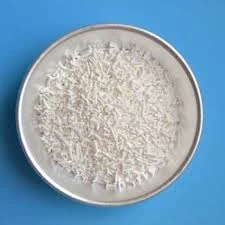
styrene butadiene rubber
Styrene-Butadiene Rubber Properties, Applications, and Future Trends
Styrene-butadiene rubber (SBR) is a synthetic rubber that has become one of the most widely used types of rubber across various industries. Developed in the 1930s, SBR is a copolymer of styrene and butadiene, each contributing unique properties that make this material highly versatile and effective for numerous applications.
Properties of Styrene-Butadiene Rubber
One of the key properties of SBR is its excellent resilience, which allows it to return to its original shape after deformation. This characteristic makes SBR ideal for applications requiring flexibility and durability. Additionally, SBR exhibits good abrasion resistance, which is crucial in environments where wear and tear are prominent. The material also has a relatively low cost compared to other synthetic rubbers, making it an economical choice for manufacturers.
SBR is particularly noted for its aging stability, which assures users of its longevity even under adverse conditions. It has decent heat resistance, although it is important to note that it does not perform as well as some other synthetic rubbers like nitrile rubber or EPDM at elevated temperatures. Nevertheless, its balance of properties makes it suitable for a wide range of rubber products.
Applications of Styrene-Butadiene Rubber
styrene butadiene rubber

SBR is predominantly used in tire manufacturing, where it accounts for a significant percentage of the rubber in tire treads. Its properties make it ideal for providing the necessary grip and traction while ensuring longevity. In addition to tire production, SBR is found in various applications, including adhesives, sealants, coatings, and molded products.
The footwear industry also utilizes SBR due to its cushioning and flexibility, while the construction sector values it in building materials for its durability and resistance to environmental factors. Furthermore, SBR is common in the production of conveyor belts, hoses, and gaskets, demonstrating its broad applicability across different fields.
Future Trends in SBR Development
As industries evolve, so do the demands placed on materials like SBR. Innovations in polymer technology are leading to the development of high-performance variants of SBR that offer improved thermal and chemical resistance, making them suitable for more demanding environments. The incorporation of sustainable practices is also becoming a key trend, with researchers exploring bio-based feedstocks to reduce the environmental impact of SBR production.
Moreover, the push for more eco-friendly products is prompting manufacturers to develop recyclable forms of SBR, enhancing its appeal across green industries. As global regulations continue to tighten regarding emissions and waste management, the transition to sustainable materials is imperative.
In conclusion, Styrene-butadiene rubber is a fundamental material in the synthetic rubber landscape, playing a crucial role in numerous sectors. Its unique combination of properties ensures its ongoing relevance, while advancements in technology and an emphasis on sustainability promise to drive the future of SBR, reinforcing its position in the market and paving the way for innovative applications. As industries strive for more efficient and environmentally friendly solutions, SBR is sure to remain at the forefront of rubber technology.
-
Understanding Synthetic Rubber OptionsNewsApr.27,2025
-
Trichloroisocyanuric Acid: Essential for Clean and Safe WaterNewsApr.27,2025
-
Sodium Dichloroisocyanurate: Key to Safe Water TreatmentNewsApr.27,2025
-
Sodium Acid Pyrophosphate: Essential in Modern Food ProcessingNewsApr.27,2025
-
Essential Water Treatment ChemicalsNewsApr.27,2025
-
Denatured Alcohol and Its Industrial UsesNewsApr.27,2025
-
The Versatile Uses of Sodium BicarbonateNewsApr.24,2025
Hebei Tenger Chemical Technology Co., Ltd. focuses on the chemical industry and is committed to the export service of chemical raw materials.
-

view more DiethanolisopropanolamineIn the ever-growing field of chemical solutions, diethanolisopropanolamine (DEIPA) stands out as a versatile and important compound. Due to its unique chemical structure and properties, DEIPA is of interest to various industries including construction, personal care, and agriculture. -

view more TriisopropanolamineTriisopropanolamine (TIPA) alkanol amine substance, is a kind of alcohol amine compound with amino and alcohol hydroxyl, and because of its molecules contains both amino and hydroxyl. -

view more Tetramethyl Thiuram DisulfideTetramethyl thiuram disulfide, also known as TMTD, is a white to light-yellow powder with a distinct sulfur-like odor. It is soluble in organic solvents such as benzene, acetone, and ethyl acetate, making it highly versatile for use in different formulations. TMTD is known for its excellent vulcanization acceleration properties, which makes it a key ingredient in the production of rubber products. Additionally, it acts as an effective fungicide and bactericide, making it valuable in agricultural applications. Its high purity and stability ensure consistent performance, making it a preferred choice for manufacturers across various industries.











